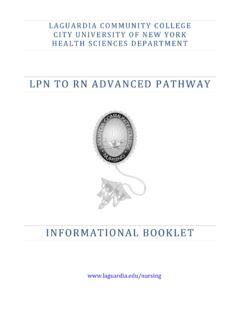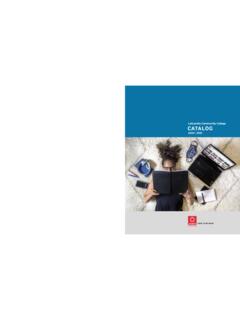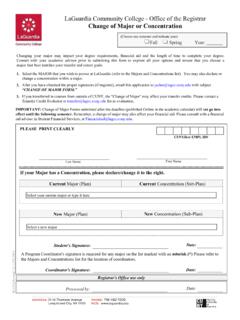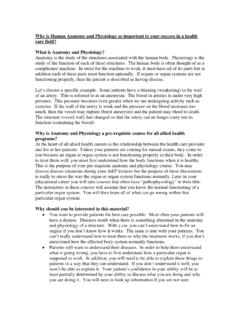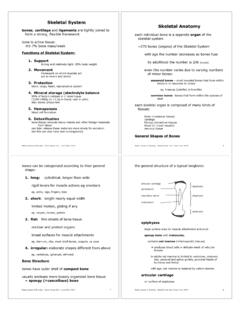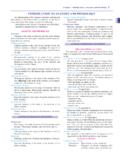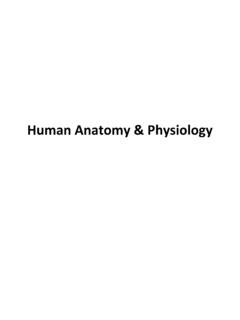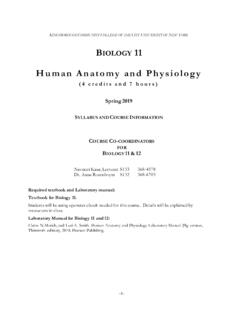Transcription of HUMAN ANATOMY AND PHYSIOLOGY
1 1 HUMAN ANATOMY AND PHYSIOLOGY SCB-203 La Guardia Community College City University of New York Department of Natural Sciences Howard K. Motoike, A & P Coordinator Revised 6/2018 2 Policy on Academic Integrity. HUMAN ANATOMY and PHYSIOLOGY (SCB-203, SCB-204) will be conducted in compliance with La Guardia Community College s Academic Integrity Policy regarding cheating on examinations and quizzes. If a student is suspected of academic misconduct or dishonesty (such as cheating, bribery or plagiarism) the instructor will complete the academic integrity complaint form. The following steps will then subsequently occur: The faculty member meets with the student charged with the violation; shows him/her the completed Complaint Form, which indicates the faculty member s sanction (either an F on the paper, quiz or exam involved: or an F in the course). The instructor asks the student to check one of the three options printed on the form.
2 The student may select I do not challenge the accusation and accept the sanctions or I challenge the accusation and wish for the matter to be referred to the Chief Adjudicator for further review or I do not wish to make any statement at this time and I am aware that the sanction will be upheld without further review for appeal after fifteen days of receipt of this notice . The form, with the evidence attached, is then signed by the student and by the faculty member and sent to the Chairperson of the department. The student should be advised that signing of the document is not considered an admission of guilt but only an understanding of the allegations and the possible sanctions filed against them. A copy of the form is given to the student and the faculty member retains a copy for his/her files. The Chairperson determines whether the matter has been resolved or not; checks the appropriate line on the complaint form; signs the form; files a copy, together with copies of the supporting evidence in the department s files; and sends a copy with the supporting evidence to the Academic Integrity Officer (AIO) in C-317.
3 If the alleged violation is discovered after the class has met for the final time in the semester, the instructor notifies the student by e-mail and certified postal mail, requesting a meeting. If the student does not respond, that is so noted on the complaint form and the form with supporting documentation is sent to the department Chairperson, who also attempts to contact the student. If the student does not respond, the form and documents, including documentation of the attempts to contact the student are sent to the AIO. If the student checks, I do not wish to make any statement at this time, or if the student refuses to sign the form at all, or if the student refuses to meet with the professor, the complaint form and attached documents are filed in the department and are sent to the AIO, who calls the student to a meeting and then determines an appropriate course of action, as described above. In cases in which the student fails to appear at the required meeting within one week of notification, the faculty sanction shall apply without benefit of student appeal.
4 The AIO functions in these processes as the representative of the Vice President of the Division of Student Affairs. The AIO promptly notifies the Chairperson of receipt of the complaint form, of the determination made by either the Academic Standing Committee or the Student-Faculty Disciplinary Committee and of the inclusion of the student s name in the division s data base of students who admit violations or who are determined to be guilty of violations. The AIO will review the data base to identify repeat offenders and to impose appropriate disciplinary sanctions. Finally, when the faculty sanction allows the student to complete work necessary for passing the course, the student is allowed to do so. When the faculty sanction is failure for the course and the student requests a hearing or chooses not to make a statement, the student remains in the course until the matter is resolved. If the matter is not resolved by the end of the term, the professor gives the student a grade that incorporates the proposed sanction, with the possibility of revision when the matter is resolved.
5 3 Grading Procedures and Criteria for HUMAN ANATOMY and PHYSIOLOGY The final grade in SCB-203 and SCB-204 is determined by the sum of the lecture and laboratory portions of the course. The lecture composes 60% and the laboratory 40% of the final grade, respectively. Lecture Exams % of the Final Grade Laboratory Exams % of the Final Grade 6 Lecture Quizzes* 30% 2 Practical Exams 20% 2 Lecture Exams 30% 2 Written Exams# 20% 60% 40% *The lowest quiz is dropped. #The laboratory final in SCB-203 also has a practical portion worth 40% of the grade. There is also a ten point clay modeling grade in SCB-203. Practical exams are based on the identification of laboratory materials displayed at stations. Written exams may include short answers, fill-ins, diagrams and essays.
6 Attendance is mandatory for all labs. It is the student s responsibility to make-up missed labs. There are no make-ups for laboratory practical exams and the student must take the exam the week it is offered during the semester. Final Grades = A = B+ = C+ = D+ = F = A- = B = C = D = B- = C- = D- SCB-203 Information Sheet Note that that there is a strict no food, no drink, no smoking and no open toed shoe policy in the laboratory. Students who fail to comply with these rules may not participate in the laboratory. Attendance is a requirement for this class. Instructors are required to keep official records of attendance. The maximum number of unexcused absences is limited to 15% of the total number of class hours. Absences are counted from the first day of class even if they are a result of late registration or change of program. Classes will meet in accordance to the Academic Calendar which may be obtained from the College s web site.
7 Classes may not be cancelled due to inclement weather. Check for announcements on the college s website or CUNY first. Refer to the College Handbook for the rights and responsibilities of students found on the college s web site. The Grading Policy for these courses is noted above. Repeat, R , grades are not given in this course and Incompletes, IN , are issued only under very restricted circumstances. In order to receive an Incomplete, a student must be passing the course and be able to document why he/she is unable to complete the course work during the semester. Both the student and the instructor must complete and sign an Incomplete Form and list the exams that must be completed before a grade is issued. Students have six months to complete the missing exams; otherwise the incomplete is automatically converted to an F grade. An Incomplete does not provide a student with an opportunity to retake exams.
8 All prior grades are retained and added into the calculation of the final grade. Note that the process for an incomplete must be initiated by the student. 4 SCB-203: HUMAN ANATOMY AND PHYSIOLOGY I Lecture Syllabus Text: HUMAN ANATOMY and PHYSIOLOGY , Second Edition by Erin C. Amerman Pearson (ISBN: 9780135230947) Lect. Lecture Topic Chapters in Amerman 1 Introduction to HUMAN ANATOMY and PHYSIOLOGY Ch. 1 (1-11, 21-30) 2 Introduction to Chemistry Ch. 2 (31-36) 3 Reactions and Ionic Bonding Ch. 2 (36-37, 41-45) 4 Covalent and Hydrogen Bonding Ch. 2 (37-41) 5 Water, pH, Acids, Bases, Salts and Buffers Ch. 2 (46-49), Ch 25 (994-995) 6 LECTURE QUIZ 1; Organic Chemistry and Carbohydrates Ch. 2 (50-52, 62) 7 Lipids and Proteins Ch. 2 (53-59, 63) 8 Nucleic Acids and Heredity Ch. 2 (59-61, 63-62, 64), Ch. 3 (112) 9 Protein Synthesis Ch. 3 (103-110) 10 Introduction to the Cell and the Cell Membrane Ch. 3 (68-87) 11 Cell Organelles Ch.
9 3 (87-103) 12 LECTURE QUIZ 2; Epithelial Tissue Ch. 4 (123-137) 13 Connective Tissue, Organs and Cell Membranes Ch. 4 (137-146, 151-154) 14 Introduction to the Integumentary System Ch. 5 (160-174) 15 Skin Derivatives and Pathology Ch. 5 (174-182 and Ch 5) 16 LECTURE QUIZ 3; Skeletal Organization Ch. 4 (144-145), Ch. 6 (184-201) 17 Skeletal PHYSIOLOGY and Articulations Ch. 6 (202-207), Ch. 8 (257-281) 18 LECTURE MIDTERM EXAM Lectures 1-17 19 Muscular Organization Ch 4 (146-148), Ch 9 (283-284, Ch. 10 (337-347) 20 Muscle PHYSIOLOGY Ch. 10 (347-363) 21 Muscles and Body Movements Ch. 10 (364-375), Ch. 9 (287-291) 22 Muscle Pathology Ch. 9 and Ch. 10 23 LECTURE QUIZ 4; Blood and its Functions Ch. 4 (145-146), Ch 25 (995-996), Ch. 19 (723-738) 24 Blood Types and Hemostasis Ch. 19 (746-751, 738-746) 25 Blood Pathology Ch. 19 26 The Heart and the Conduction System Ch. 4 (148-149), Ch. 17 (630-652) 27 The Electrocardiogram and the Cardiac Cycle Ch.)
10 17 (652-661) 28 Control of Cardiac Function and Pathology Ch. 17 (662-666), Ch. 17 29 LECTURE QUIZ 5; Introduction to Blood Vessels Ch. 18 (670-675), Ch 4 (148), Ch. 27 (1081-1083) 30 Circulatory PHYSIOLOGY Ch. 18 (675-696) 31 Structure and Mechanics of the Respiratory System Ch. 21 (802-817) 32 PHYSIOLOGY and Chemistry of Respiration Ch. 21 (818-840) 33 Regulation of Respiration and Respiratory Disorders Ch. 21 (840-846) and Ch. 21 34 LECTURE QUIZ 6; The Lymphatic System Ch. 20 (754-762) 35 Introduction to Immunity, Innate Immunity, Cell Mediated Immunity Ch. 20 (762-780) 36 Antibody Mediated Immunity and Immune Disorders Ch. 20 (780-797) LECTURE FINAL EXAM (during finals week) Lectures 19-36 The laboratory syllabus is included in the laboratory manual package if purchased from the college book store. 5 SCB-203 HUMAN ANATOMY AND PHYSIOLOGY I OUTLINE OF THE LECTURE OBJECTIVES Lecture 1: Introduction to HUMAN ANATOMY and PHYSIOLOGY .






